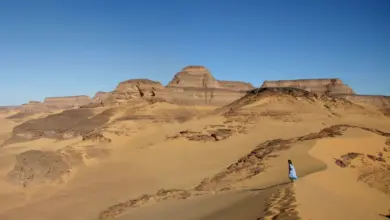Since the 18th century, Egypt has had a public authority responsible for the registration, inventory and security of its antiquities in museums and archaeological sites — currently the Ministry of Antiquities. But it has rarely been able to stir up the general public’s interest in their own rich heritage.
Other than groups such as the friends of the Egyptian or Coptic museums, until recently few people have tried to engage non-specialists. TV programs on the subject remain dull and alienating.
“Government authorities in Egypt have usually preferred giving priority to tourists over Egyptians,” says Yasmine El Dorghamy, editor of Rawi Magazine.
In 2008, when Dorghamy decided to launch a magazine about heritage, she wanted to present an informative publication about history and heritage made attractive through good design and photography.
“I am particularly targeting young bilingual Egyptians, a social segment that needs to know more about our invaluable heritage,” she explains. Covering various topics and most historical periods from Ancient Egypt to contemporary times, Rawi has made its way to Cairo’s newsstands, as well as the bookstores of international museums such as the British Museum and the Louvre.
“Dozens of people came to help us rescue the books at the Institut d’Egypte when the fire broke out last December,” Dorghamy says. “People were happy to help … This experience made me believe that many Egyptians feel the importance and the value of their heritage, they only need some guidance regarding what they can do to help.” This guidance has never been sufficiently provided by the public antiquities authorities, educational system or media.
Independent groups have recently emerged to try to make up for this lack through lectures and public awareness campaigns, inspired by the positive spirit displayed in the cleaning of Tahrir Square after Hosni Mubarak stepped down.
“Every day new groups are formed,” says Dalia Nabil, who co-founded the Treasures of Egypt at Risk group along with Heba Hosny. “If the revolution has succeeded in anything, then it is regaining our belief in our ability to effect change and combat ignorance and corruption.”
Other recently-founded groups aiming to protect ancient antiquities, archaeological sites, and urban and architectural heritage include the Front for Saving Egyptian Antiquities, Save al-Moez Street, the Heliopolis Heritage Initiative, and the Egyptian Archaeologist. Some aim to raise general awareness about Egyptian heritage while others focused on protecting specific historic areas.
Such groups are largely confined to Cairo and Alexandria, and the upscale Cairene district of Heliopolis has in particular seen a proliferation of initiatives actively protecting urban and architectural heritage by engaging the local community.
Known at the dawn of the 20th century as the “Oasis of Heliopolis” due to being almost in the desert, Heliopolis is a quarter that still keeps a good percentage of its original urban planning and buildings built in the Neo-Islamic architectural style that emerged in 1905. The idea of establishing Heliopolis belonged to the Belgian industrialist Baron Edouard Empain, owner of the famous Baron Palace in Orouba Street. Several initiatives have been active of late protecting these buildings, including Treasures of Egypt at Risk and the Heliopolis Heritage Initiative.
“Our mission is to protect our built environment from the abrupt destruction it is currently facing,” says Nabil, whose group tries to safeguard the architectural and urban heritage of Heliopolis through documenting it, evaluating the pros and cons of the built environment, and more importantly by launching a trial initiative to motivate a local community of experts, schools, civil initiatives and stakeholders to help protect the district’s architecture through various actions. They particularly focus on sharing experiences of sustainable conservation and preservation, hoping that this will pressure local authorities to enforce the relevant legislation.
More urgently, Treasures of Egypt at Risk has also tried to protect an important old Heliopolis building about to be demolished by its owner without an official demolition permit. “When we reported the crime to the relevant authorities, the National Organization for Urban Harmony and the Cairo Governorate, the slow mechanisms they have for dealing with such urgent cases of vandalism and taking preventive measures actually hindered them from saving many listed buildings, and so no pragmatic action was taken when it was desperately needed, and the historic building was lost,” says Nabil.
The ongoing destruction of Heliopolis’s original buildings has also pushed two initiative groups to launch the Heliopolis Eyes campaign, which specifically aims to monitor any threat to this heritage. “The main objective of Heliopolis Eyes is to create a watchdog community participating in safeguarding its heritage through photo documentation and monitoring the historic built environment in Heliopolis,” says Nabil.
Most of these initiatives use social media to connect with similar groups and announce activities such as lectures, meetings and fieldtrips. “More people are joining our initiative,” says Nabil. “The majority of them are young. This assures me that change will happen soon.”
Heliopolis Eyes meetings have succeeded in bringing together people who were previously acting individually to protect architectural heritage. “I love history and heritage and I've been getting emotional seeing beautiful old buildings with characteristic style getting threatened or demolished, and was taking their photos as well,” said Suzanne al-Fiky, an architect who regularly contributes to Heliopolis Eyes. “Such initiatives aiming to make people more aware of history and heritage can be considered a first step in a long term process of awakening Egyptians to their invaluable inheritance.”
Bloggers have also joined in. Michel Hanna is a pharmacist who has been writing regularly about Cairo’s endangered architectural heritage for two years. A recent post, “The Glories of Heliopolis,” was about the area’s original buildings being partially or completely destroyed. Old black and white photos of the buildings next to recent photos of them added to the post’s impact. “I strongly believe that the state is the only responsible body that has the power to stop this destruction of our architectural heritage,” says Hanna.
An important partner in Heliopolis Eyes, alongside Treasures of Egypt at Risk and Megawra Built Environment, is the Heliopolis Heritage Initiative, recently launched as part of MP Amr Hamzawy’s plan for his Heliopolis constituency.
The initiative’s large scope aims to cover architectural heritage protection, green zones and parks enhancement, cultural heritage protection and activities, traffic and transport solutions, and waste management challenges. In order to drum up interest, it has conducted a photography competition on the architectural heritage of Heliopolis. It organized weekly guided tours so people could photograph important buildings and get to know more of the area’s history and architecture. “The participants were of all ages and genders — I would say mostly younger photographers in their twenties,” says Ahmed Mansour, an architect and member of the initiative. “They were very much interested in the history being told, the old pictures being exposed to them in order to reproduce them in the current setting, the old names of the streets.”
This interest shows that the time is ripe for such independent initiatives to be extended from the two major cities to communities in the Delta and the Nile Valley, where important aspects of Egypt’s cultural history could also be lost.




